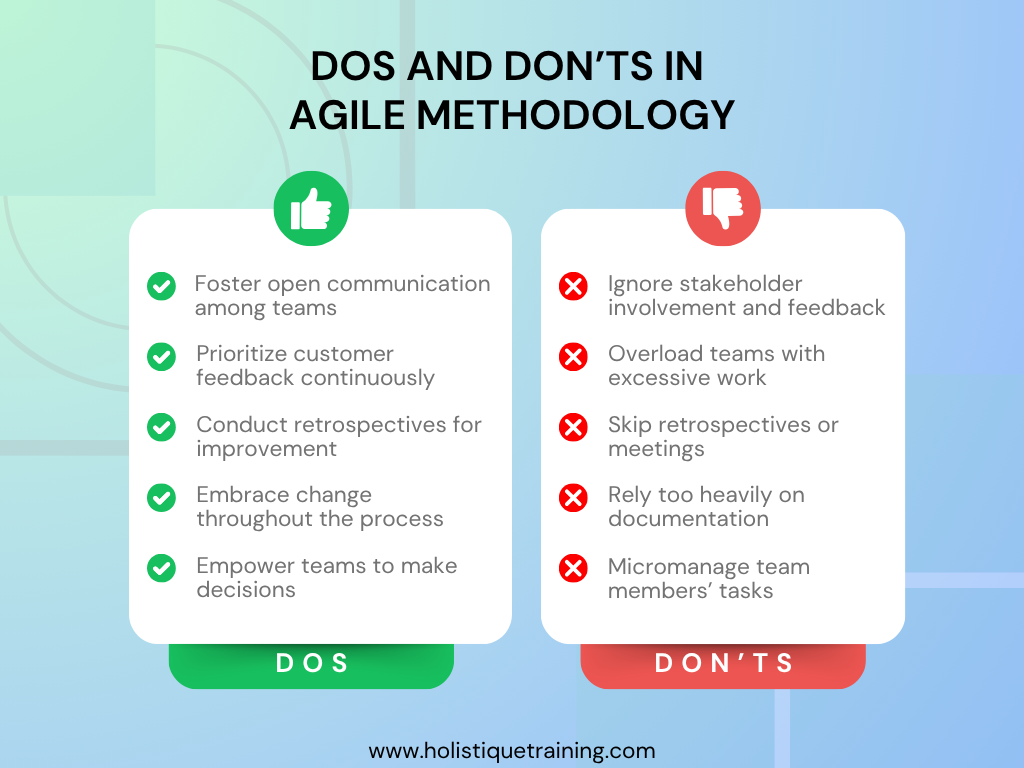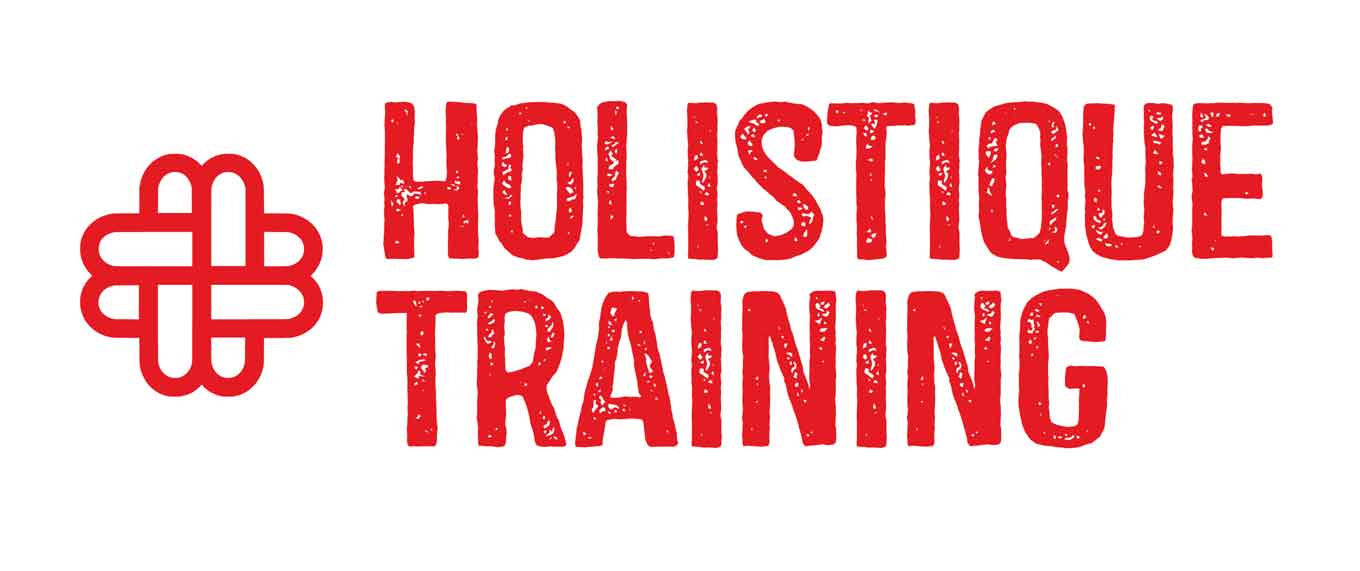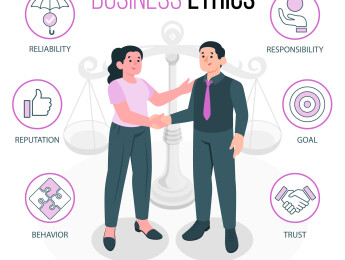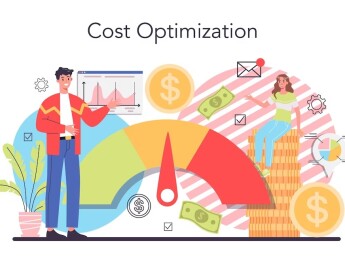- Table of Contents
- Introduction
- What is Agile Methodology?
- Why is Agile Methodology Important?
- Flexibility and Adaptability
- Faster Time-to-Market
- Enhanced Collaboration
- Customer-Centric Approach
- Improved Quality
- Empowered Teams
- Continuous Improvement
- Agile Project Management vs. Waterfall Project Management: Key Differences
- 1. Structure and Process
- 2. Customer Involvement
- 3. Risk Management
- 4. Documentation
- 5. Team Dynamics
- How to Introduce Agile
- 1. Educate and Train Teams
- 2. Start Small
- 3. Foster a Culture of Collaboration
- 4. Establish Clear Roles
- 5. Utilize Agile Tools
- 6. Iterate and Improve
- 15 Mistakes in Agile Methodology & Solutions to Avoid Them
- 1. Lack of Understanding of Agile Principles
- 2. Insufficient Stakeholder Involvement
- 3. Ignoring Team Dynamics
- 4. Overemphasis on Documentation
- 5. Failure to Adapt to Change
- 6. Neglecting Retrospectives
- 7. Inadequate Sprint Planning
- 8. Ignoring Technical Debt
- 9. Lack of a Defined Product Vision
- 10. Micromanagement by Leadership
- 11. Inconsistent Agile Practices
- 12. Neglecting User Feedback
- 13. Overloading Teams with Work
- 14. Ignoring Cross-Functional Collaboration
- 15. Lack of Continuous Improvement
- Conclusion
Introduction
Agile methodology has revolutionized the way teams approach project management, especially in software development. Its iterative nature and emphasis on collaboration have made it a preferred choice for many organizations seeking flexibility and responsiveness. However, despite its benefits, the journey to successful agile implementation is fraught with pitfalls. This blog post will delve into the concept of agile methodology, its significance, and the critical differences between agile and waterfall project management. Furthermore, we will explore how to introduce agile practices effectively and identify 15 common mistakes organizations make when adopting agile, along with practical solutions to avoid them. By understanding these challenges and their solutions, teams can navigate the agile landscape more effectively and reap the full benefits of this dynamic approach.
What is Agile Methodology?
Agile methodology is a project management framework that promotes iterative development, where requirements and solutions evolve through collaboration between self-organizing cross-functional teams. It emphasizes flexibility, customer collaboration, and rapid delivery of functional software. Agile methodologies encourage adaptive planning and evolutionary development, allowing teams to respond to changes quickly and efficiently.
At its core, agile is built on the principles outlined in the Agile Manifesto, which values:
- Individuals and interactions over processes and tools
- Working software over comprehensive documentation
- Customer collaboration over contract negotiation
- Responding to change over following a plan
These principles guide teams in delivering high-quality products that meet customer needs while fostering a culture of continuous improvement.
Why is Agile Methodology Important?
The importance of agile methodology stems from its ability to address the limitations of traditionalproject management approaches, particularly in fast-paced environments. Here are several key reasons why agile is essential:
Flexibility and Adaptability
In an era where market conditions and customer preferences can shift rapidly, the ability to adapt is crucial. Agile methodology embraces change rather than resisting it. Teams that adopt agile practices can pivot quickly in response to new information, allowing them to adjust project scopes, timelines, and deliverables based on real-time feedback. This flexibility not only helps in meeting customer expectations but also positions organizations to seize emerging opportunities and mitigate risks more effectively.
Faster Time-to-Market
Agile methodologies break projects into smaller, manageable increments known as sprints. This iterative approach enables teams to deliver functional components of a product more quickly, significantly reducing the time-to-market. By focusing on delivering a minimum viable product (MVP) initially, organizations can launch sooner and gather user feedback early in the development process. This rapid delivery cycle allows teams to refine their products continuously, ensuring that they remain relevant and competitive.
Enhanced Collaboration
Agile fosters a culture of collaboration among team members, stakeholders, and customers. Regular meetings, such as daily stand-ups and sprint reviews, promote open communication and transparency. This collaborative environment encourages cross-functional teams to work together toward common goals, leveraging diverse skill sets and perspectives. As a result, organizations benefit from improved problem-solving capabilities and innovative solutions that arise from collective brainstorming and shared knowledge.
Customer-Centric Approach
One of the cornerstone principles of agile is customer collaboration. Agile methodologies prioritize engaging customers throughout the development process, ensuring that their needs and feedback are integral to product evolution. By involving customers in regular reviews and demonstrations, teams can validate assumptions, identify potential issues, and make necessary adjustments before final delivery. This customer-centric approach not only enhances satisfaction but also builds trust and loyalty, as clients feel valued and heard.
Improved Quality
The iterative nature of agile allows for regular testing and feedback loops, which are essential for identifying defects early in the development cycle. Continuous integration and testing ensure that quality is built into the product from the start, rather than being an afterthought. By addressing issues as they arise, teams can reduce the amount of rework needed later, leading to a more polished final product. Moreover, the focus on delivering small increments of working software enables teams to maintain high standards of quality throughout the project lifecycle.
Empowered Teams
Agile methodologies promote self-organization and empower teams to take ownership of their work. Unlike traditional project management approaches that often rely on top-down directives, agile encourages team members to collaborate on decision-making and problem-solving. This empowerment fosters a sense of accountability and motivation, as team members feel more invested in the success of their projects. When individuals have the autonomy to make choices and contribute to the process, it can lead to higher job satisfaction and increased productivity.
Continuous Improvement
Agile is not just a set of practices; it embodies a philosophy of continuous improvement. The regular retrospectives that agile teams conduct provide opportunities to reflect on what went well and what could be improved. By fostering a culture of learning, teams can identify inefficiencies, experiment with new approaches, and implement changes that enhance their processes. This commitment to ongoing improvement not only benefits individual projects but also contributes to the overall maturity of the organization’s agile practices.
In summary, the importance of agile methodology lies in its ability to enable organizations to navigate the complexities of modern project management effectively. By embracing flexibility, fostering collaboration, and prioritizing customer engagement, agile empowers teams to deliver high-quality products that meet evolving market demands. As businesses continue to face unprecedented challenges and opportunities, adopting agile practices can be a game-changer, positioning them for sustained success in a dynamic environment.
Agile Project Management vs. Waterfall Project Management: Key Differences
Understanding the differences between agile project management and traditional waterfallproject management is essential for organizations contemplating a shift to agile practices.
1. Structure and Process
- Agile: Agile is iterative and incremental, allowing for continuous refinement and adaptation. Projects are divided into short cycles, known as sprints, where teams focus on delivering specific features or components.
- Waterfall: Waterfall follows a linear, sequential approach. Each phase must be completed before moving on to the next, making it less flexible to changes that may arise during the project.
2. Customer Involvement
- Agile: Customer feedback is integral throughout the development process. Regular reviews and demos ensure that the product aligns with customer expectations.
- Waterfall: Customer involvement is typically limited to the initial requirements gathering phase and final delivery, which can lead to misalignment with customer needs.
3. Risk Management
- Agile: Risks are identified and addressed continuously throughout the project lifecycle, allowing teams to pivot as necessary.
- Waterfall: Risks are often assessed at the beginning of the project, making it challenging to respond to unforeseen issues that arise later.
Aspect | AgileProject Management | Waterfall Project Management |
Approach | Iterative and incremental | Sequential and linear |
Flexibility | Highly adaptable to changes | Rigid with little flexibility |
Customer Involvement | Continuous throughout the process | Limited to initial requirements |
Delivery | Frequent increments and releases | Single final delivery |
Risk Management | Early identification and mitigation | Risks assessed at the end |
4. Documentation
- Agile: Emphasizes working software over comprehensive documentation. While documentation is still important, it is often streamlined to focus on what is necessary for the team and stakeholders.
- Waterfall: Places a strong emphasis on detailed documentation at each phase, which can lead to delays and bureaucratic overhead.
5. Team Dynamics
- Agile: Encourages self-organizing teams that collaborate closely and take ownership of their work.
- Waterfall: Typically involves more hierarchical structures, with clear roles and responsibilities defined at the outset.
These differences highlight why organizations may choose agile over waterfall, especially in environments where adaptability and customer feedback are crucial.
How to Introduce Agile
Introducing agile methodology into an organization requires careful planning and execution. Here are some steps to facilitate a successful transition:
1. Educate and Train Teams
Before implementing agile practices, it is crucial to ensure that all team members understand the core principles and methodologies of agile. This education can take various forms, such as:
- Workshops and Training Sessions: Organize hands-on workshops where teams can learn about agile frameworks like Scrum or Kanban. These sessions should cover the key concepts, roles, and processes involved in agile methodology.
- Agile Coaches: Consider hiring experienced agile coaches who can mentor teams throughout the transition. Coaches can provide tailored guidance, share best practices, and help teams navigate challenges during the adoption process.
- Online Resources and Certifications: Encourage team members to pursue online courses or certifications in agile methodologies. This not only enhances their knowledge but also fosters a culture of continuous learning.
2. Start Small
Rather than attempting to overhaul the entire organization at once, it is advisable to start with a pilot project. This approach allows teams to experiment with agile practices in a controlled environment. Here are some steps to consider:
- Select a Suitable Project: Choose a project that is manageable in scope and has a clear business need. Ideally, this project should involve cross-functional teams and stakeholders who are open to collaboration.
- Define Success Metrics: Establish clear metrics to evaluate the success of the pilot project. These could include factors such as delivery speed, quality of output, team satisfaction, and customer feedback.
- Iterate and Learn: Use the pilot project as a learning opportunity. Gather feedback from team members and stakeholders throughout the process, and be willing to adapt practices based on what works and what doesn’t.
3. Foster a Culture of Collaboration
Collaboration is at the heart of agile methodology. To create an environment that supports teamwork, consider the following strategies:
- Encourage Open Communication: Promote a culture where team members feel comfortable sharing ideas, asking questions, and providing feedback. Regular check-ins and open forums can facilitate this communication.
- Cross-Functional Teams: Form cross-functional teams that bring together members from different departments or disciplines. This diversity can lead to innovative solutions and a broader understanding of the project’s goals.
- Team-Building Activities: Organize team-building exercises to strengthen relationships among team members. These activities can help build trust and improve collaboration, making it easier for teams to work together effectively.
4. Establish Clear Roles
Defining roles within the agile team is essential for clarity and accountability. Key roles typically include:
- Product Owner: Responsible for defining the product vision, prioritizing features, and ensuring that the team delivers value to stakeholders.
- Scrum Master: Acts as a facilitator for the team, helping to remove obstacles, enforce agile practices, and support continuous improvement.
- Development Team Members: Cross-functional individuals who work collaboratively to deliver increments of the product.
By clearly establishing these roles and responsibilities, teams can operate more efficiently and effectively, minimizing confusion and enhancing productivity.
5. Utilize Agile Tools
Implementing the right tools can significantly enhance the agile process. Consider the following tools and technologies:
- Project Management Software: Use tools like Jira, Trello, or Asana to manage tasks, track progress, and visualize workflows. These tools can help teams stay organized and focused on their goals.
- Collaboration Platforms: Leveragecollaboration tools like Slack or Microsoft Teams to facilitate communication among team members. These platforms enable real-time discussions and quick sharing of information.
- Version Control Systems: Implementversion control systems (e.g., Git) to manage code changes and ensure that team members can collaborate effectively on development tasks.
6. Iterate and Improve
Agile is fundamentally about continuous improvement. To embed this philosophy into the organization, consider the following:
- Regular Retrospectives: Schedule regular retrospectives at the end of each sprint to reflect on what went well and what could be improved. Encourage open and honest discussions to identify actionable insights.
- Feedback Loops: Create mechanisms for continuous feedback from both team members and stakeholders. This feedback can inform adjustments to processes, practices, and priorities.
- Experimentation: Foster a culture that encourages experimentation and innovation. Allow teams to try new approaches, tools, or techniques, and learn from both successes and failures.
Table: Metrics to measure the effectiveness of agile methodology
Metric | Description |
Velocity | Measures the amount of work completed in a sprint |
Lead Time | Time taken from request to delivery of a feature |
Cycle Time | Time taken to complete a task from start to finish |
Customer Satisfaction | Feedback from customers on product quality and usability |
Defect Density | Number of defects per unit of work delivered |
Introducing agile methodology is a significant undertaking that can yield substantial benefits for organizations willing to embrace change. By educating teams, starting with pilot projects, fostering collaboration, defining clear roles, utilizing effective tools, and committing to continuous improvement, organizations can successfully navigate the transition to agile practices. This journey not only enhances project outcomes but also cultivates a culture of adaptability and innovation, positioning organizations for long-term success in a dynamic business landscape.
15 Mistakes in Agile Methodology & Solutions to Avoid Them
Despite the advantages of agile methodology, many organizations encounter challenges during implementation. Below are 15 common mistakes teams make when adopting agile, along with solutions to avoid them.
1. Lack of Understanding of Agile Principles
Mistake: Many teams adopt agile practices without fully grasping the underlying principles, leading to a superficial implementation that does not yield the expected benefits.
Solution: Invest incomprehensive training and education about agile principles and methodologies. Conduct workshops, invite agile coaches, and create a resource hub with materials that explain the core concepts of agile. Ensure that all team members, including leadership, understand the agile mindset and its implications for their roles.
2. Insufficient Stakeholder Involvement
Mistake: Failing to involve stakeholders and customers throughout the development process can result in misaligned expectations and dissatisfaction with the final product.
Solution: Establish regular touchpoints with stakeholders, such as sprint reviews and demos, to gather feedback and ensure alignment. Encourage stakeholders to participate actively in the agile ceremonies, fostering a sense of ownership and collaboration. This engagement helps ensure that the product evolves according to user needs.
3. Ignoring Team Dynamics
Mistake: Neglecting the importance of team dynamics can hinder collaboration and productivity. Teams may struggle to communicate effectively or may not leverage each member's strengths.
Solution: Foster a culture of trust and open communication. Encourage team-building activities that strengthen relationships and improve collaboration. Regularly assess team dynamics through feedback sessions and adjust processes to enhance teamwork. Consider implementing tools that facilitate better communication and collaboration among team members.
4. Overemphasis on Documentation
Mistake: Some teams mistakenly believe that agile means no documentation, leading to gaps in communication and knowledge transfer. This can result in misunderstandings and a lack of clarity regarding project objectives.
Solution: Strike a balance between necessary documentation and agile principles. Focus on creating lightweight, relevant documentation that supports the team’s work. Use tools like user stories, acceptance criteria, and task boards to maintain clarity without overwhelming the team with excessive paperwork.
5. Failure to Adapt to Change
Mistake: Teams may struggle to embrace change, sticking rigidly to plans and processes even when new information suggests a different direction. This rigidity can lead to missed opportunities.
Solution: Encourage a mindset of adaptability. Emphasize that change is a natural part of the agile process and should be welcomed rather than resisted. Regularly review project goals and priorities, and be willing to pivot based on feedback and evolving circumstances. Foster a culture where team members feel empowered to suggest changes based on new insights.
6. Neglecting Retrospectives
Mistake: Skipping retrospectives or treating them as a formality can prevent teams from learning and improving. Without reflection, teams may repeat the same mistakes.
Solution: Treat retrospectives as a critical component of the agile process. Encourage honest feedback and actionable insights to drive continuous improvement. Use structured formats for retrospectives, such as Start-Stop-Continue or the 4Ls (Liked, Learned, Lacked, Longed for), to facilitate meaningful discussions. Ensure that action items from retrospectives are tracked and addressed in subsequent sprints.
7. Inadequate Sprint Planning
Mistake: Poorly planned sprints can lead to confusion, missed deadlines, and unmet expectations. Teams may not have a clear understanding of what needs to be accomplished.
Solution: Invest time in thorough sprint planning. Clearly define sprint goals, prioritize tasks, and ensure the team has a shared understanding of the work ahead. Use techniques like story point estimation to gauge the team’s capacity and avoid overcommitting. Encourage team members to voice concerns during planning to ensure realistic commitments.
8. Ignoring Technical Debt
Mistake: Teams may prioritize delivering features over addressing technical debt, leading to long-term maintenance issues and decreased product quality.
Solution: Allocate time in each sprint to address technical debt. Regularly assess and prioritize technical improvements alongside feature development. Create a backlog specifically for technical debt items, and ensure that the team dedicates a portion of their capacity to resolving these issues. This proactive approach helps maintain product quality and reduces future rework.
9. Lack of a Defined Product Vision
Mistake: Without a clear product vision, teams may struggle to align their efforts with business goals, resulting in disjointed development and wasted resources.
Solution: Develop a well-defined product vision that guides the team’s work. Involve key stakeholders in creating this vision to ensure alignment with business objectives. Communicate the vision clearly to all team members, and refer back to it regularly during planning and execution to maintain focus.

10. Micromanagement by Leadership
Mistake: Leaders may inadvertently micromanage agile teams, undermining their autonomy and self-organization. This can lead to frustration and reduced morale.
Solution: Empower teams to make decisions and take ownership of their work. Leadership should focus on providing support and guidance rather than controlling every aspect of the process. Encourage leaders to trust their teams and allow them the freedom to experiment and learn from their experiences. Establish clear expectations and outcomes, but let teams determine how to achieve them.
11. Inconsistent Agile Practices
Mistake: Teams may adopt agile practices inconsistently, leading to confusion and inefficiency. Without a standardized approach, team members may struggle to understand their roles and responsibilities.
Solution: Establish a consistent approach to agile practices within the organization. Create guidelines and standards that teams can follow while allowing for flexibility based on project needs. Regularly review and refine these practices to ensure they remain relevant and effective. Encourage knowledge sharing among teams to promote best practices and alignment.
12. Neglecting User Feedback
Mistake: Failing to gather and incorporate user feedback can result in products that do not meet user needs, leading to dissatisfaction and reduced adoption.
Solution: Implement regular user testing and feedback sessions. Involve users early and often to ensure that the product aligns with their expectations. Use techniques such as user interviews, surveys, and usability testing to gather insights. Incorporate this feedback into the development process to make informed decisions and improve the product continuously.
13. Overloading Teams with Work
Mistake: Teams may take on too much work in a sprint, leading to burnout and decreased quality. This overload can result from pressure to deliver quickly or poor sprint planning.
Solution: Encourage teams to limit their work in progress (WIP) and focus on delivering high-quality results. Use techniques like Kanban to visualize work in progress and identify bottlenecks. Implement strict sprint capacity planning to ensure that teams commit to a manageable amount of work. Promote a culture that values quality over quantity, emphasizing that delivering fewer features well is preferable to delivering many features poorly.
14. Ignoring Cross-Functional Collaboration
Mistake: Teams may operate in silos, neglecting collaboration with other departments. This can lead to miscommunication and a lack of alignment on project goals.
Solution: Promote cross-functional collaboration by involving members from different departments in agile teams. This diversity can lead to more innovative solutions and improved outcomes. Encourage regular communication between teams, and consider implementing joint planning sessions or workshops to foster collaboration. Establish shared goals that require input and cooperation from multiple teams.
15. Lack of Continuous Improvement
Mistake: Teams may become complacent, failing to seek opportunities for improvement. This stagnation can prevent the organization from fully realizing the benefits of agile.
Solution: Foster a culture of continuous improvement by regularly evaluating processes and outcomes. Encourage experimentation and innovation to drive ongoing enhancements. Implement metrics to track performance and identify areas for improvement. Celebrate successes and learn from failures, reinforcing the idea that every experience is an opportunity for growth.
By recognizing and addressing these common mistakes, organizations can enhance their agile practices and maximize the benefits of this methodology. Implementing the proposed solutions requires commitment and a willingness to adapt, but the rewards—improved collaboration, faster delivery, and higher-quality products—are well worth the effort. As teams navigate the agile landscape, continuous learning and improvement will be key to their success, enabling them to thrive in an ever-changing environment.
Conclusion
Adopting agile methodology can significantly enhance an organization’s ability to respond to change, deliver high-quality products, and foster a collaborative culture. However, the journey to agile success is not without its challenges. By recognizing and addressing the common mistakes outlined in this blog post, teams can navigate the agile landscape more effectively.
Understanding the principles of agile, fostering collaboration, and continuously seeking improvement are essential components of a successful agile implementation. As organizations embrace agile, they must remain committed to learning and evolving, ensuring that they harness the full potential of this dynamic methodology. With the right mindset and practices in place, teams can thrive in an agile environment, delivering exceptional value to their customers and stakeholders.
To further enhance your agile journey, consider enrolling in our “Disciplined Agile Scrum Master (DASM) Certification course”. This comprehensive program equips participants with the skills and knowledge necessary to effectively lead agile teams and implement disciplined agile practices. By gaining a deeper understanding of agile principles and methodologies, you will be better prepared to guide your organization towards agile excellence, ensuring sustainable success in today's fast-paced business landscape.
























